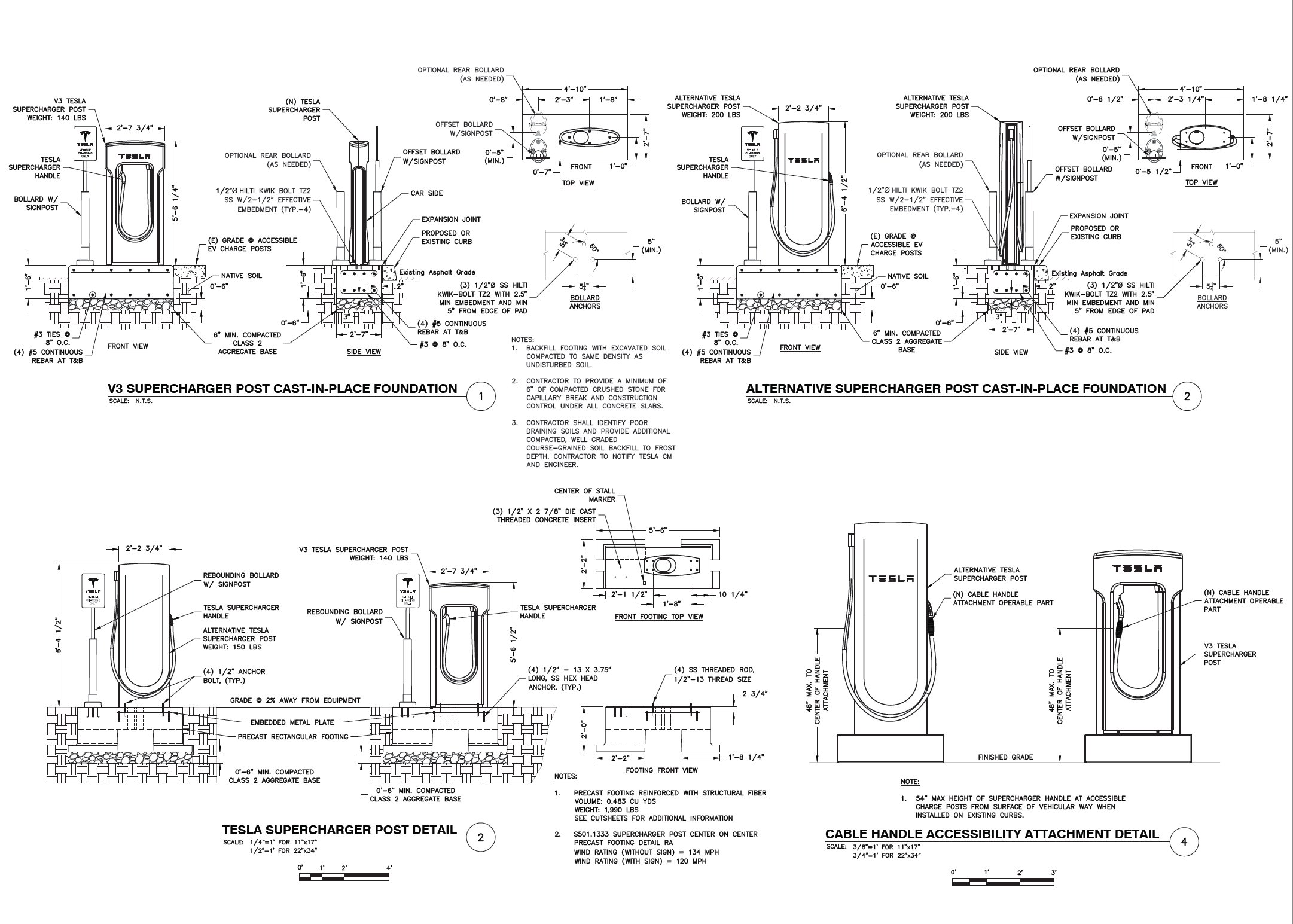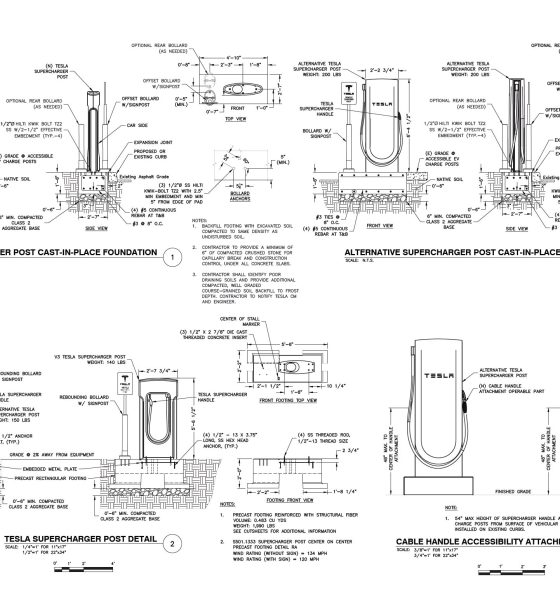Tesla’s V4 Supercharger appeared in new project plans for a site in Danvers, Massachusetts, with a design that is strikingly similar to the company’s 72 kW Urban Supercharger. However, project details outlined in blueprints for the Danvers Supercharger seem to indicate this is Tesla’s next big development in its next-gen charging posts, but some questions still remain.
Tesla’s V4 Supercharger
Tesla’s V4 Supercharger will, of course, succeed the 250 kW-capable V3 Superchargers that were released in 2019. The V3 Supercharger was an outrageous update and a huge development to the expedited process of charging Tesla’s EVs. Rates of up to 1,000 miles of range added per hour are capable with the V3 Superchargers, but they are also only available to Tesla vehicles, which is where the V4 may be coming into play.
Along with the rumored CSS support that the V4 Supercharger will pack, Tesla seems to be revising a recently-released 72 kW Urban Supercharger design for the new stalls. In the project outline for the Danvers, Massachusetts Supercharger, the design for the “Alternative Supercharger Post” is strikingly similar, but there are a few details that lead us to believe this is what Tesla is planning to utilize for the new design.
Tesla’s Urban Supercharger can be wall-mounted and installed virtually anywhere
Initially, the Alternative design in the blueprints is massive: 6′ 4.5″, weighing 200 pounds. That’s significantly larger than the Urban Supercharger, which is compact and perhaps only four feet or less in height. It towers over the V3 Supercharger design, which is also present in the blueprints and seems to be the project’s more-likely outfitting when it is complete (courtesy of @JH_Beford on Twitter).

Credit: John Bedford @JH_Bedford on Twitter
We recently reported on some rumors surrounding the V4 Supercharger design, and it does appear to be somewhat similar from a very elementary perspective to what descriptions of the new shell would be. However, there are some things that still remain in question as the V4 Supercharger design has not yet been made public by Tesla.
CCS Support
The project design lacks any mention of potential CCS Support on the V4 Supercharger, which is what most people would expect moving forward from Tesla. The automaker has been utilizing a Pilot Program in Europe that allows other EV brands to utilize Supercharger stalls. This project is available in sixteen countries in Europe, and Tesla has made it clear that, eventually, the capability will be available in the United States. For now, it is too much of an advantage as Tesla continues to grow, and the company keeps it exclusive to Tesla vehicles in the U.S.
However, as we are already a month into the second half of 2022, it gives Tesla less time to roll out the “new Supercharger equipment that will enable non-Tesla EV drivers in North America to use Tesla Superchargers.” These quoted words come courtesy of the White House.
CCS Support may not be on these designs for several reasons, and it could be that Tesla simply hasn’t finalized a design for that Supercharger. Additionally, this could be an entirely different design altogether, and while it could be the V4 Supercharger, Tesla may not have plans to put CCS Support on the V4. That could perhaps be saved for another design.
900v Architecture
Tesla’s V4 Supercharger will also likely support ultra-fast charging architectures like a rumored 900V setup for the Cybertruck. These higher-voltage architectures enable ultra-fast charging and can supply high-performance or high-workload vehicles with range in short amounts of time.
Tesla is also likely to head toward a 350 kW charging rate, which is present in Electrify America chargers. These chargers are perfect for high-voltage vehicles as they can charge vehicles faster, and most importantly, the vehicles can support them. Their higher voltage architecture can stabilize the charging process for these higher-powered chargers. The Porsche Taycan has an 800v architecture, which enables faster charging, less weight, and high performance, all at lower temperatures.
I’d love to hear from you! If you have any comments, concerns, or questions, please email me at joey@teslarati.com. You can also reach me on Twitter @KlenderJoey, or if you have news tips, you can email us at tips@teslarati.com.

News
Tesla FSD fleet is nearing 7 billion total miles, including 2.5 billion city miles
As can be seen on Tesla’s official FSD webpage, vehicles equipped with the system have now navigated over 6.99 billion miles.

Tesla’s Full Self-Driving (Supervised) fleet is closing in on almost 7 billion total miles driven, as per data posted by the company on its official FSD webpage.
These figures hint at the massive scale of data fueling Tesla’s rapid FSD improvements, which have been quite notable as of late.
FSD mileage milestones
As can be seen on Tesla’s official FSD webpage, vehicles equipped with the system have now navigated over 6.99 billion miles. Tesla owner and avid FSD tester Whole Mars Catalog also shared a screenshot indicating that from the nearly 7 billion miles traveled by the FSD fleet, more than 2.5 billion miles were driven inside cities.
City miles are particularly valuable for complex urban scenarios like unprotected turns, pedestrian interactions, and traffic lights. This is also the difference-maker for FSD, as only complex solutions, such as Waymo’s self-driving taxis, operate similarly on inner-city streets. And even then, incidents such as the San Francisco blackouts have proven challenging for sensor-rich vehicles like Waymos.
Tesla’s data edge
Tesla has a number of advantages in the autonomous vehicle sector, one of which is the size of its fleet and the number of vehicles training FSD on real-world roads. Tesla’s nearly 7 billion FSD miles then allow the company to roll out updates that make its vehicles behave like they are being driven by experienced drivers, even if they are operating on their own.
So notable are Tesla’s improvements to FSD that NVIDIA Director of Robotics Jim Fan, after experiencing FSD v14, noted that the system is the first AI that passes what he described as a “Physical Turing Test.”
“Despite knowing exactly how robot learning works, I still find it magical watching the steering wheel turn by itself. First it feels surreal, next it becomes routine. Then, like the smartphone, taking it away actively hurts. This is how humanity gets rewired and glued to god-like technologies,” Fan wrote in a post on X.
News
Tesla starts showing how FSD will change lives in Europe
Local officials tested the system on narrow country roads and were impressed by FSD’s smooth, human-like driving, with some calling the service a game-changer for everyday life in areas that are far from urban centers.

Tesla has launched Europe’s first public shuttle service using Full Self-Driving (Supervised) in the rural Eifelkreis Bitburg-Prüm region of Germany, demonstrating how the technology can restore independence and mobility for people who struggle with limited transport options.
Local officials tested the system on narrow country roads and were impressed by FSD’s smooth, human-like driving, with some calling the service a game-changer for everyday life in areas that are far from urban centers.
Officials see real impact on rural residents
Arzfeld Mayor Johannes Kuhl and District Administrator Andreas Kruppert personally tested the Tesla shuttle service. This allowed them to see just how well FSD navigated winding lanes and rural roads confidently. Kruppert said, “Autonomous driving sounds like science fiction to many, but we simply see here that it works totally well in rural regions too.” Kuhl, for his part, also noted that FSD “feels like a very experienced driver.”
The pilot complements the area’s “Citizen Bus” program, which provides on-demand rides for elderly residents who can no longer drive themselves. Tesla Europe shared a video of a demonstration of the service, highlighting how FSD gives people their freedom back, even in places where public transport is not as prevalent.
What the Ministry for Economic Affairs and Transport says
Rhineland-Palatinate’s Minister Daniela Schmitt supported the project, praising the collaboration that made this “first of its kind in Europe” possible. As per the ministry, the rural rollout for the service shows FSD’s potential beyond major cities, and it delivers tangible benefits like grocery runs, doctor visits, and social connections for isolated residents.
“Reliable and flexible mobility is especially vital in rural areas. With the launch of a shuttle service using self-driving vehicles (FSD supervised) by Tesla in the Eifelkreis Bitburg-Prüm, an innovative pilot project is now getting underway that complements local community bus services. It is the first project of its kind in Europe.
“The result is a real gain for rural mobility: greater accessibility, more flexibility and tangible benefits for everyday life. A strong signal for innovation, cooperation and future-oriented mobility beyond urban centers,” the ministry wrote in a LinkedIn post.
News
Tesla China quietly posts Robotaxi-related job listing
Tesla China is currently seeking a Low Voltage Electrical Engineer to work on circuit board design for the company’s autonomous vehicles.

Tesla has posted a new job listing in Shanghai explicitly tied to its Robotaxi program, fueling speculation that the company is preparing to launch its dedicated autonomous ride-hailing service in China.
As noted in the listing, Tesla China is currently seeking a Low Voltage Electrical Engineer to work on circuit board design for the company’s autonomous vehicles.
Robotaxi-specific role
The listing, which was shared on social media platform X by industry watcher @tslaming, suggested that Tesla China is looking to fill the role urgently. The job listing itself specifically mentions that the person hired for the role will be working on the Low Voltage Hardware team, which would design the circuit boards that would serve as the nervous system of the Robotaxi.
Key tasks for the role, as indicated in the job listing, include collaboration with PCB layout, firmware, mechanical, program management, and validation teams, among other responsibilities. The role is based in Shanghai.
China Robotaxi launch
China represents a massive potential market for robotaxis, with its dense urban centers and supportive policies in select cities. Tesla has limited permission to roll out FSD in the country, though despite this, its vehicles have been hailed as among the best in the market when it comes to autonomous features. So far, at least, it appears that China supports Tesla’s FSD and Robotaxi rollout.
This was hinted at in November, when Tesla brought the Cybercab to the 8th China International Import Expo (CIIE) in Shanghai, marking the first time that the autonomous two-seater was brought to the Asia-Pacific region. The vehicle, despite not having a release date in China, received a significant amount of interest among the event’s attendees.









